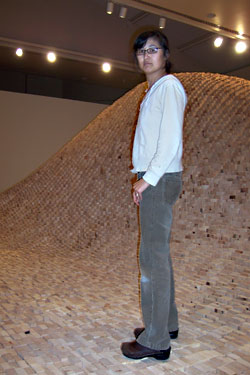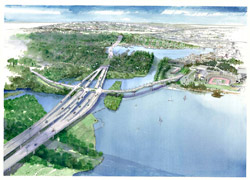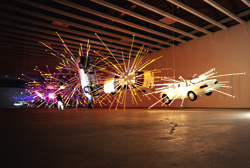A clump of schoolkids crosses the corridor of the Henry Art Gallery, oblivious that the unassuming figure nearby, in a sweat top, pony tail, and clogs, designed one of the most significant war monuments of the last century—when she herself was just a student.
That was 1981 when Maya Lin, a 21-year-old architecture undergrad at Yale, created the winning design for the Vietnam Veterans Memorial in Washington, D.C. Now 47, the internationally renowned artist and sculptor has made numerous significant memorials since. Her April 20 lecture at the University of Washington’s 700-seat Kane Hall sold out in three days.
“Systematic Landscapes,” her new show, which opens at the Henry this week, is her first museum exhibit in eight years. It is expansive both conceptually and literally—filling the museum’s entire lower floor—and includes new work, bronze maquettes of past projects, a video overview of her career, plus cardboard models for the Confluence Project, her current ambitious undertaking along the Columbia River commemorating the exploration of Lewis and Clark and Native American history.
Dominating the space are two pieces: 2 x 4 Landscape, a solid hill/wave made of 65,000 hemlock blocks, and Water Line, a vast wire topography of an island near Antarctica.
“I think in everything I’ve done, especially the large-scale art installations, I’m tweaking you to take a different look at the natural world,” says Lin. This show brings outdoor landscapes inside—not just into the building, but into viewers’ heads. Working indoors for a change freed her to explore new concepts.
With 2 x 4, she answers her own question: “What is it like to walk on a hill and touch the ceiling?” She smiles with the satisfied wonder of a child who has just achieved the seemingly impossible. (Her youngest daughter, Rachel, is determined to climb the sculpture. Visitors to the Henry are invited to as well.)
Water Line extends across the East Gallery like a spiderweb, spiking up where the island it maps rises above sea level. It’s high enough to walk under. The balcony overlooking the gallery puts you at sea level. It’s one of the best uses of the Henry’s challenging East Gallery space in recent memory. Lin says she’s not trying to make a political statement, but “from an environmental point of view, I think we do tend to have a horrible habit—we just see the surface of the ocean, so we pollute it as much as we want. You don’t see below its surface, therefore you continue to degrade it.”
Lin’s latest work can sound a little arcane at first: imaginary topographies rendered in wire, a hill of two-by-fours inspired by pixilated TV images. But as Lin talks, you realize this is not cool, mathematical precision on display. Water Line, for example, is not to any scale other than its own. Lin created the work before finding the actual island to match her imagination.
“I don’t let the data form the end product,” she says. “It informs the end product, but in no means is it about the accuracy. And in that sense, I have always seen myself coming out of the landscape painters of the 17th and 18th century.”
Nowadays, Lin points out, “We get to look at landscape from an airplane, we get to see landscape from a sonar view of the ocean floor, we get to see a landscape of incredible view of space. We just have amazing tools that help us look at the natural world, and that has become part of the vocabulary I’m using.”
At the core of all Lin’s work is an environmentalist’s respect for nature and a humanitarian’s empathy for people: the fallen soldiers of Vietnam, civil rights activists, Native American tribes whose land was traversed, documented, but not understood.
When first asked to be the lead artist for the Confluence Project, Lin declined. “I don’t think commemorating Lewis and Clark discovering and opening up the Pacific Northwest is where my head is at right now,” was her first reaction. Eventually, she agreed to meet with representatives from the project. “It was members of the Umatilla, the Nez Perce, and the Chinook tribes. And they said, ‘We think you could look at this in a different way.’ I remember the meeting, I was almost crying.” Lin takes off her glasses and blinks. Clearly she was swayed.








